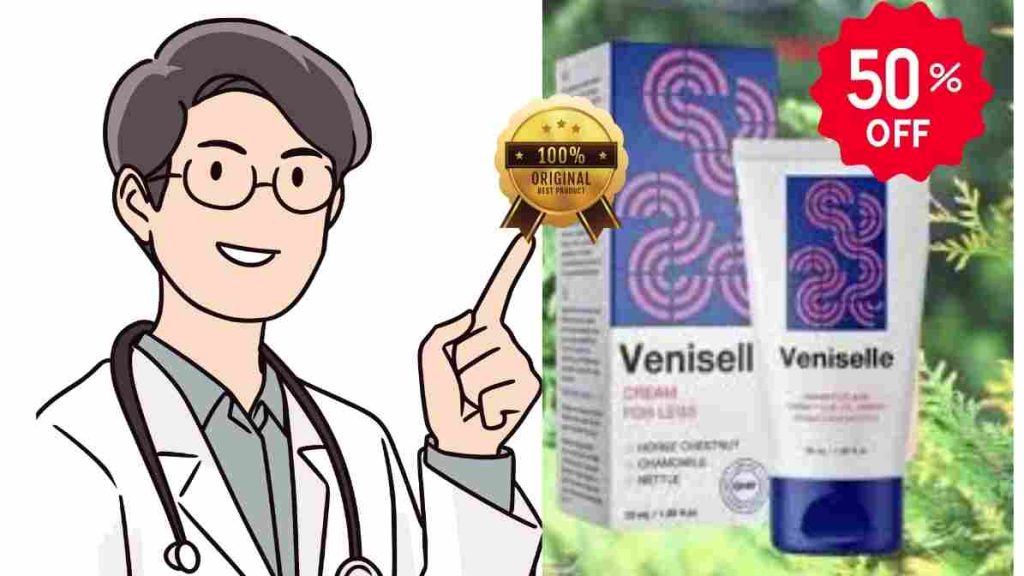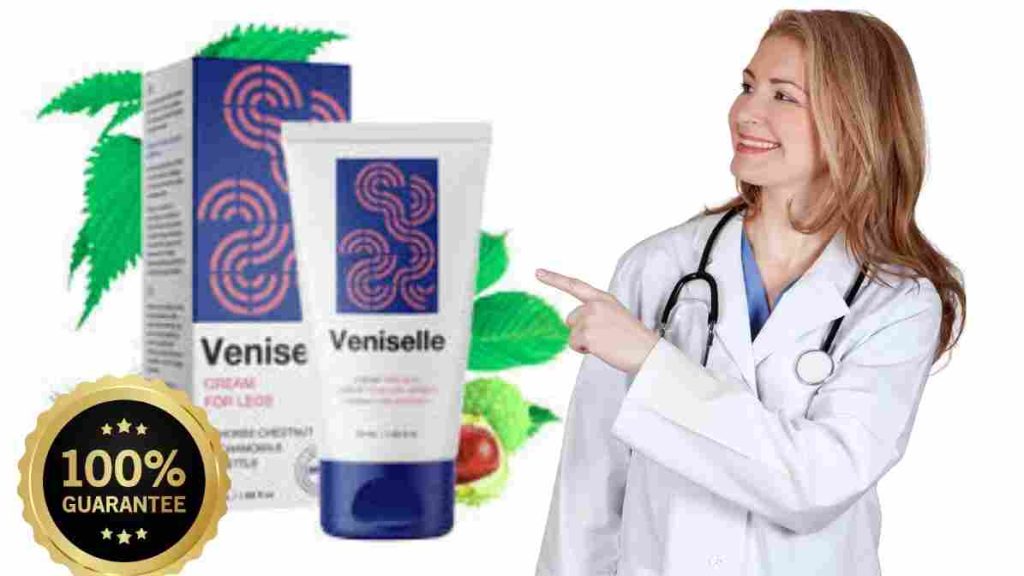Varicose veins and leg vein pain can make daily life uncomfortable, especially for seniors, athletes, or anyone on their feet often. If you’ve felt throbbing, aching, or a heavy, swollen sensation in your legs, you know the frustration of leg vein pain. Finding the best cream for leg vein pain can help you relax and enjoy life again.
In this comprehensive guide, we explain what causes painful leg veins, share proven natural remedies (like exercise, diet, and compression socks), and show how combining those with an effective cream—specifically Veniselle—can bring relief. We’ll cover everything from symptoms and lifestyle tips to why Veniselle cream stands out as a top varicose vein cream for legs.
Understanding Leg Vein Pain and Varicose Veins
Leg vein pain often stems from varicose veins, which are enlarged, swollen veins typically visible under the skin. Varicose veins look like twisted, bulging cords, often dark blue or purple. They most commonly appear on the legs and ankles, because gravity makes blood flow in the legs more challenging. If vein valves weaken or break down, blood can pool in the veins, causing them to stretch and bulge.
Many people have varicose veins without knowing it. According to health statistics, up to 20–30% of adults (around 30–40 million Americans) develop varicose veins in their lifetime. Women are affected more often than men, especially after pregnancy or around menopause. People over 50, pregnant women, and anyone with a family history of vein problems face higher risk. Leg vein pain can include symptoms like:
- Aching or throbbing: A dull pain or cramp-like feeling, especially after standing or walking.
- Heavy, tired legs: A sensation of pressure or heaviness in calves or thighs.
- Burning, itching, or tingling: Skin around the veins may feel irritated or itchy.
- Swelling: Ankles or feet can swell, especially by day’s end.
- Restlessness: Troubled sleep or leg cramps at night, due to vein discomfort.
These symptoms often worsen after long periods of standing or sitting. Resting with your legs elevated usually brings relief. While varicose veins are mostly not dangerous, the pain and discomfort can seriously affect quality of life. In some cases, chronic varicose veins can lead to skin changes or ulcers. For this reason, doctors emphasize early self-care and symptom management.
According to the NHS (UK’s National Health Service), varicose veins are common and usually harmless, but they do cause leg heaviness and swelling. You can help ease symptoms by elevating your legs, keeping a healthy weight, and being active. In fact, regular exercise and leg elevation are part of the “things you can do” to manage vein symptoms.
Also, the American Heart Association notes that varicose veins affect about 30 million American adults and highlights risk factors like age, pregnancy, and obesity. In short, leg vein pain is widespread, but not inevitable. With the right lifestyle and topical treatments, you can significantly reduce discomfort.
Common Causes and Risk Factors
Leg vein pain and varicose veins develop when the veins’ internal valves weaken. Blood that should flow upward toward the heart instead pools in the leg veins, causing them to stretch. Key factors that contribute to this include:
- Aging: Over time, vein walls and valves naturally weaken. Seniors often notice varicose veins as a result.
- Genetics: If your parents had leg vein issues, you’re more likely to too. Family history plays a big role.
- Gender: Women get varicose veins more often than men. Hormonal changes (pregnancy, menopause, birth control pills) relax vein walls. Up to two-thirds of women may experience varicose veins in adulthood.
- Pregnancy: The growing uterus puts pressure on leg veins, and hormonal shifts loosen vein walls. Many women see vein pain worsen during pregnancy.
- Obesity: Carrying extra weight increases pressure on leg veins. Being overweight or obese is a major risk factor for painful veins.
- Occupation: Jobs that involve long hours of standing or sitting (teachers, nurses, factory workers, drivers, etc.) encourage blood pooling. If you’re on your feet all day or sit with legs bent, consider this a risk.
- Lifestyle: Sedentary habits worsen poor circulation. A lack of regular exercise means your calf muscles aren’t pumping blood back to your heart efficiently.
- Injury and Illness: Prior leg injuries, surgeries, or blood clots (deep vein thrombosis) can damage veins and lead to varicose veins.
Understanding these factors helps explain why seniors, athletes, and people with chronic pain often struggle with leg vein issues. For example, an athlete who trains hard might strain leg muscles and aggravate veins, while a senior’s veins naturally weaken with age. Even tall people may have higher odds of varicose veins (as height has been linked to risk).
Key takeaway: Leg vein pain is usually caused by weakened vein valves and poor circulation. Risk factors include age, genetics, pregnancy, obesity, and lifestyle. Knowing your risk can motivate you to take preventive action.
Natural Remedies and Lifestyle Tips for Leg Vein Pain
If you’re dealing with leg vein pain or varicose veins, there are effective natural remedies and lifestyle changes you can start right away. These won’t make veins disappear completely, but they can ease symptoms and slow progression. Combine these habits with a good topical cream for maximum relief.
- Regular Exercise: Physical activity is one of the best ways to boost circulation and relieve leg pain. Low-impact exercises like walking, cycling, swimming or gentle yoga make calf muscles work to pump blood upward. Even simple walking for 30 minutes daily can significantly improve blood flow. A Cleveland Clinic specialist emphasizes that a nightly walk is a top recommendation— it gets blood moving after a day of sitting or standing. Calf raises, ankle circles, and leg stretches (including elevating legs above the heart) are easy exercises you can do at home.
- Maintain Healthy Weight: Losing excess weight removes pressure on your leg veins. Even a modest weight loss can make a difference in reducing vein swelling and leg pain. Healthy diet and regular activity go hand in hand here.
- Compression Garments: Special compression socks or stockings gently squeeze the legs, preventing veins from expanding. By supporting the veins and muscles, they reduce throbbing and swelling. Medical studies show that wearing knee-high compression stockings (with proper pressure) even for a week can cut down varicose pain. According to experts, compression wear is “probably the most effective home remedy” for varicose discomfort. Compression gear is available in various strengths and styles (knee-high, thigh-high, leggings). Your doctor or pharmacist can help choose the right level of compression.
- Elevate Your Legs: Whenever you sit or lie down, prop your legs up on a stool or pillows so they are at or above heart level. Even 15–20 minutes of leg elevation a few times per day can significantly improve circulation. Gravity helps blood flow back to the heart, reducing pressure in the leg veins. The NHS recommends elevating legs on cushions while resting, and this simple trick often provides quick relief.
- Avoid Long Periods of Sitting or Standing: If your work requires you to stand or sit for hours, make it a point to take breaks. Walk around a bit every hour, or alternate sitting and standing. Avoid crossing your legs for long when seated. When standing, shift your weight frequently. Small changes like these prevent blood from pooling.
- Eat a Vein-Healthy Diet: Include fiber-rich foods (whole grains, legumes, fruits, vegetables) to prevent constipation and straining, which can worsen vein pressure. Add foods high in flavonoids (antioxidant compounds) – for example, berries, citrus fruits, red grapes (grape seed extract), buckwheat, onions, spinach, and green tea. Flavonoids can strengthen blood vessel walls and reduce inflammation. Dr. Boyle at Cleveland Clinic highlights rutin (a flavonoid) as promising for varicose symptoms. Also focus on potassium-rich foods like bananas, oranges, tomatoes, and leafy greens. A potassium-rich diet helps lower blood pressure, easing strain on veins.
- Stay Hydrated: Drink plenty of water each day. Good hydration thins the blood slightly and supports healthy circulation.
- Gentle Leg Massage: Lightly massage your legs in upward strokes toward the heart. This can temporarily relieve swelling and discomfort. Be cautious: don’t press hard on the veins themselves; focus on surrounding muscle and tissue. Use a soothing lotion or oil during massage. Massaging combined with a topical cream (like Veniselle) can enhance blood flow and reduce tension.
- Herbal Supplements: Some natural supplements may help vein health. In studies, horse chestnut seed extract (often in topical gels or pills) has reduced vein pain and swelling due to its anti-inflammatory properties. Grape seed extract is another antioxidant that can improve circulation. Always check with a doctor before taking new supplements, but herbs like horse chestnut are common in varicose remedies.
- Wear Loose Clothing: Tight pants, leggings, or girdles can restrict blood flow. Opt for loose, comfortable clothing and flat or low-heel shoes to encourage good circulation.
In summary, these natural remedies for leg vein pain – exercise, elevation, diet, compression, and massage – work together to improve circulation and soothe symptoms. They are especially important for anyone who spends long hours on their feet or has other risk factors. Implementing even a few of these tips can make your legs feel lighter and reduce daily pain.
How to Reduce Varicose Veins Naturally
If you’re asking “how to reduce varicose veins naturally,” the answer lies largely in prevention and symptom management. While home remedies can’t eliminate existing varicose veins, they can help prevent them from getting worse and reduce discomfort. Key strategies include:
- Consistent Leg Movement: Keep blood moving by walking, standing up, and doing gentle leg exercises every day. Avoid inactivity.
- Leg Position: Sleep with a pillow under your calves or back, or try “legs up the wall” yoga pose. Elevating your legs overnight or during long travel relieves vein pressure.
- Healthy Diet and Weight: As mentioned above, eating plenty of fiber and antioxidants (vitamins C and E) strengthens vein walls. Losing even 5–10 pounds if overweight can slow the progression of varicose veins.
- Stay Cool: Heat causes veins to dilate. After exercise or a long day, cool your legs with a short cool-water shower or foot bath. Avoid hot baths and saunas if you have vein pain.
- Avoid Tobacco: Smoking damages blood vessels and impairs circulation. Quitting smoking is crucial for overall vascular health.
By following these natural approaches – movement, diet, elevation, and avoiding harm – many people can reduce leg vein symptoms and even see some improvement in vein appearance. For example, regular calf exercises and a high-fiber diet can make spider veins and small varicosities less prominent over time.
Varicose Vein Cream for Legs: Choosing the Best Topical Treatment
Creams for varicose veins are designed to ease leg vein pain and support healthy circulation. When choosing a varicose vein cream for legs, look for these features:
- Active Ingredients: Effective creams often contain herbal extracts and nutrients. Key ingredients to seek include horse chestnut extract (anti-inflammatory, improves vein tone), flavonoids like troxerutin or rutin (found in buckwheat and grape seed), menthol (cooling pain relief), and antioxidants (vitamin C, grape seed). Many vein creams also use chamomile or aloe to soothe skin. Veniselle, for instance, combines horse chestnut, chamomile, nettle, menthol and other natural extracts to relieve swelling and pain.
- Fast Absorption: A non-greasy formula that penetrates skin quickly ensures you can go about your day immediately after application. Many top creams are formulated as gels or light lotions.
- Moisturizing Base: Creams that hydrate dry, flaky skin around varicose areas can reduce itchiness and irritation. Look for added Vitamins E and A, which nourish the skin.
- Evidence of Safety: Since creams are applied daily, check that the product has been tested for safety. Ideally, pick one free of harsh chemicals, steroids or parabens. Natural ingredients are gentler on sensitive skin.
- User Reviews: Though not “ingredients,” it’s useful to see feedback. Creams widely praised for results often rate highly on retailer sites. (Veniselle, for example, has received positive user comments for reducing leg throbbing and heaviness.)
How creams help: A topical varicose cream won’t make veins vanish (only medical procedures can do that). However, it can significantly reduce pain, throbbing, and swelling. Creams improve micro-circulation near the skin’s surface, cool inflamed areas, and provide a soothing massage effect when applied. When used alongside lifestyle changes, a cream can enhance blood flow back to the heart and prevent stagnation in leg veins.
Why Veniselle Stands Out as the Best Cream for Leg Vein Pain
Among the available varicose vein creams, Veniselle stands out as a top choice. It’s known as the “best cream for leg vein pain” by many users and health bloggers because of its natural formula and effectiveness. Here’s why Veniselle excels:
- Natural, Clinically Studied Ingredients: Veniselle’s formula is rich in plant-based extracts with proven benefits. It contains horse chestnut, which is well-known to strengthen vein walls and improve blood flow. It also has troxerutin-like flavonoids, vitamins, and nettles that work as gentle anti-inflammatories. These ingredients help normalize blood microcirculation, reduce capillary permeability (so less fluid leaks into tissues), and relieve swelling. In fact, medical experts note horse chestnut is one of the most effective natural remedies for varicose symptoms.
- Cooling Relief: Each application delivers a light menthol cooling sensation. This instantly soothes pain and gives tired legs a refreshed feeling. Many users report that Veniselle quickly alleviates the burning or throbbing sensation associated with varicose veins.
- Easy to Use: The cream’s texture is creamy yet absorbs easily, leaving skin smooth but not oily. It spreads well over the calf, ankles, and thighs. You can even massage the cream into your feet and ankles to relieve foot fatigue. Because it’s non-greasy, you can apply Veniselle and then put on clothes or go about your day without feeling sticky.
- Prevents Worsening: Regular use of Veniselle doesn’t just relieve current pain—it helps prevent further vein damage. The active ingredients support healthy collagen and elastin in vein walls, making veins more resilient. Over time, this can mean fewer flare-ups of swelling or cramping.
- Suitable for All Ages: Veniselle is formulated for adults of any age group (18 to 70). It’s free of steroids or hormones, so seniors and younger adults alike can use it safely. Even athletes and active people find it refreshing after a workout.
- Customer Satisfaction: Official product sites and retailers note that many users see noticeable comfort after just a week of use. People praise it for turning sore, restless legs into relaxed, lighter legs. This real-world feedback suggests Veniselle delivers on its promises.
In short, Veniselle brings together the best features of a varicose vein cream for legs: it combines powerful natural actives (like horse chestnut and flavonoids) with a pleasant cooling effect and ease of use. These qualities make it a standout option when comparing vein creams. Many reviewers even say it offers faster relief than other gels or ointments they’ve tried.
How to Use Veniselle Cream
To get the most benefit from Veniselle (and any vein cream), consistent application is key. Here’s a simple step-by-step routine:
- Cleanse Skin: Wash and gently dry your legs before applying. Clean skin absorbs the cream better.
- Apply a Small Amount: Squeeze a pea-sized amount onto your fingertips. You don’t need a lot—a little goes a long way on the lower legs.
- Massage Upward: Rub the cream into the skin, massaging gently from ankles upward toward the heart. Focus on areas that feel most painful or swollen. This upward stroke helps push blood toward the torso.
- Use Twice Daily: For best results, apply Veniselle twice a day (morning and evening). Many users also like to apply it at bedtime, so it works on swelling as you relax.
- Combine with Elevation (Optional): After applying, you can elevate your legs for a few minutes to maximize circulation. Sitting or lying with feet propped up shortly enhances the cream’s effect.
- Wear Compression Socks: If you have severe swelling, you can wear light compression socks over the area after applying Veniselle. This locks in the cream and adds further support (though in most cases cream alone is sufficient).
By following these steps regularly, you create a daily vein-care habit. Over weeks, you should notice less burning, aching, and heaviness in your legs. Many users report improved leg appearance too—mild swelling goes down and the skin tone evens out from the cream’s soothing action.
Benefits of Veniselle Cream
Veniselle offers a variety of benefits that target both the symptoms and causes of leg vein pain:
- Pain Relief: The menthol in Veniselle provides an instant cooling sensation that calms throbbing and aching. Chamomile and nettle extracts soothe inflammation. Together, they work quickly to alleviate pain after each application.
- Reduces Swelling: By improving microcirculation and strengthening vein walls, Veniselle helps fluid drain out of congested tissues. This means ankles and calves stay less puffy, even after long days of standing. Users often note visibly reduced leg swelling within a few weeks.
- Improves Circulation: The formula’s phlebotonic action (from ingredients like horse chestnut and flavonoids) promotes healthy blood flow in leg veins. Better circulation means you feel lighter and more energetic, rather than heavy-legged.
- Softens Skin: Beyond pain relief, Veniselle hydrates and softens skin. It can minimize itchiness and dryness that often come with varicose-prone skin. Vitamin and plant oils in the cream help nourish the skin barrier.
- Prevents Cramping: Regular use can lessen leg cramps, especially those nighttime calf cramps. Many users with chronic vein pain find their restless legs calm down.
- Psychological Comfort: There’s also a mental benefit. Knowing you have an effective cream like Veniselle can reduce anxiety about leg pain. The soothing massage ritual each day encourages mindfulness and relaxation.
Call to action: Ready to ease your leg vein pain? Combining Veniselle cream with daily healthy habits is a smart approach. Visit the official Veniselle site to learn more and order (note: site may offer discounts). Always follow the usage instructions, and feel free to consult your healthcare provider if you have questions.
If you’re struggling with chronic pain or discomfort, it might be due to internal inflammation. To dive deeper into how you can combat this naturally, don’t miss our complete beginner’s guide on Natural Ways to Reduce Body Inflammation. It covers simple lifestyle changes, anti-inflammatory foods, and proven tips to help you feel better from the inside out.
FAQs about Leg Vein Pain and Creams
Q: What is the best cream for leg vein pain?
A: Many experts and users point to Veniselle as the best cream for leg vein pain. Its blend of horse chestnut, menthol, and plant extracts quickly cools and eases aching veins. Veniselle targets the root causes of discomfort by improving circulation and reducing inflammation. While individual results vary, Veniselle is widely praised for turning heavy, painful legs into relaxed, lighter legs with consistent use.
Q: Can I relieve leg vein pain naturally without medication?
A: Yes. You can manage and relieve leg vein pain with natural methods alongside topical creams. Simple steps like walking regularly, wearing compression stockings, elevating your legs, eating a high-fiber diet and staying hydrated can make a big difference. Adding a vein health cream like Veniselle amplifies these efforts. Many people find that combining natural remedies (exercise, diet, leg elevation) with a good cream provides noticeable relief without needing pills.
Q: What ingredients should I look for in a vein cream?
A: Look for natural, vascular-supporting ingredients. Key ones include horse chestnut extract (supports vein tone), flavonoids (like troxerutin or rutin, from plants), menthol or peppermint (for cooling), and vitamins (like C and E). Avoid creams with strong steroids or unknown chemicals. A good vein cream should be moisturizing and contain elements known to improve blood flow. Veniselle, for example, lists horse chestnut, chamomile, nettle, and menthol—all excellent vein helpers.
Q: How quickly will I feel relief using a cream like Veniselle?
A: Some people feel immediate relief from the cooling menthol as soon as they apply the cream. Others notice a reduction in swelling and aching after a few days of consistent use. For best results, use Veniselle daily for at least 2–4 weeks. Over time, the cream’s nutrients work cumulatively to strengthen veins. In most cases, you should see gradual improvement in pain and leg heaviness within a month.
Q: Are there side effects or risks with using vein creams?
A: Topical vein creams like Veniselle are generally safe, especially since they contain natural extracts. Side effects are rare but can include mild skin irritation or allergic reactions (if you’re sensitive to any ingredient). It’s wise to patch-test new cream on a small skin area first. Because Veniselle is hormone- and steroid-free, it’s safe for most adults, including seniors. However, if you have an open wound or ulcer on your leg, consult a doctor before applying any cream.
Q: When should I seek medical treatment for varicose veins?
A: Home remedies and creams work for many mild cases. However, you should see a doctor if: your leg pain is severe or worsening, you have leg ulcers, open sores, bleeding from a vein, or signs of infection (redness, heat). Medical professionals can offer treatments like sclerotherapy or laser ablation for advanced cases. Remember, creams like Veniselle help symptom relief but cannot cure very severe varicose veins. Early intervention with a specialist ensures the best outcomes.
Q: Does elevating my legs really help?
A: Absolutely. Elevating your legs above heart level for 15–20 minutes at a time greatly assists blood return and reduces leg pressure. It’s one of the simplest ways to alleviate vein discomfort naturally. Try reading or resting with your legs up, or even lying down with feet on pillows. It complements any cream you use, because the cream’s ingredients work best when circulation is optimal.
By combining these tips and the gentle power of Veniselle cream, you can effectively manage leg vein pain and improve leg health. Remember, the key is consistency—pairing daily lifestyle changes with Veniselle creates a powerful one-two punch against varicose discomfort. Over time, these practices help you walk, jog, and move with less pain and greater comfort. Don’t let leg vein pain slow you down—take action with the best cream and healthy habits today!







